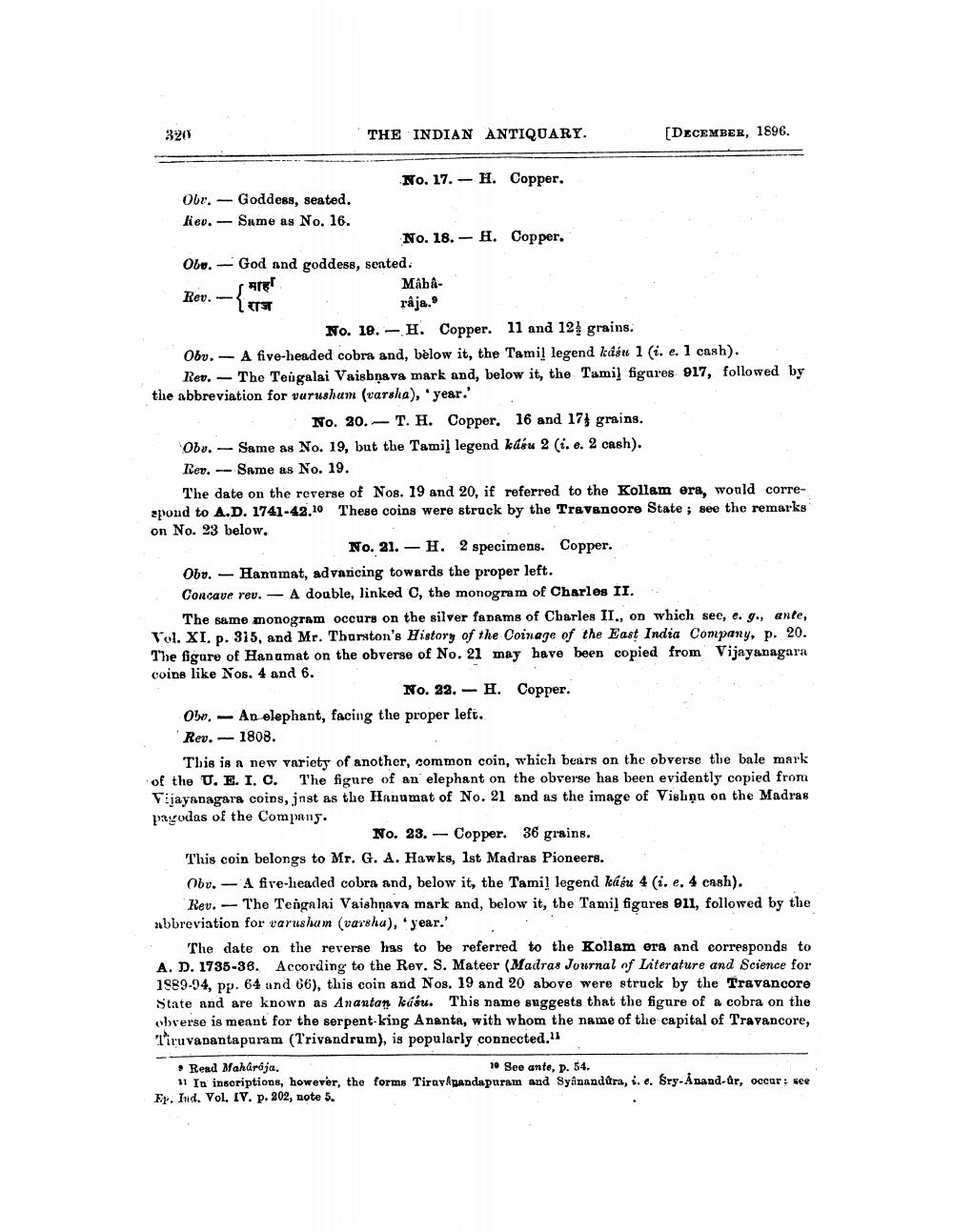________________
320
Obr. Rev.
-
Goddess, seated. Same as No. 16.
THE INDIAN ANTIQUARY.
No. 17. H. Copper.
Obe. God and goddess, seated.
माह
Rev.-{
ET ST
No. 18.
Obv. Rev.
-
Mâbâraja.s
H. Copper.
No. 18. H. Copper. 11 and 12 grains.
The Teugalai Vaishnava mark and, below it, the Tamil figures 917, followed by the abbreviation for varusham (varsha), 'year.'
Obv. A five-headed cobra and, below it, the Tamil legend kasu 1 (i. e. 1 cash). Rev.
No. 20. T. H. Copper. 16 and 17 grains.
Obs. Same as No. 19, but the Tamil legend kasu 2 (i. e. 2 cash).
Rev.
Same as No. 19.
The date on the reverse of Nos. 19 and 20, if referred to the Kollam era, would correspond to A.D. 1741-42.10 These coins were struck by the Travancore State; see the remarks on No. 23 below.
No. 21. H. 2 specimens. Copper.
Obv. Hanumat, advancing towards the proper left.
Concave rev.
A double, linked C, the monogram of Charles II.
[DECEMBER, 1896.
The same monogram occurs on the silver fanams of Charles II., on which see, e. g., ante, Vol. XI. p. 315, and Mr. Thurston's History of the Coinage of the East India Company, p. 20. The figure of Hanumat on the obverse of No. 21 may have been copied from Vijayanagara coins like Nos. 4 and 6.
No. 22. H. Copper.
An elephant, facing the proper left. 1808.
This is a new variety of another, common coin, which bears on the obverse the bale mark of the U. E. I. C. The figure of an elephant on the obverse has been evidently copied from Vijayanagara coins, just as the Hanumat of No. 21 and as the image of Vishnu on the Madras pagodas of the Company.
No. 23. - Copper. 36 grains.
This coin belongs to Mr. G. A. Hawks, 1st Madras Pioneers.
Obv.
A five-headed cobra and, below it, the Tamil legend kasu 4 (i. e. 4 cash).
Rev. The Tengalai Vaishnava mark and, below it, the Tamil figures 911, followed by the abbreviation for varusham (varsha), 'year.'
The date on the reverse has to be referred to the Kollam era and corresponds to A. D. 1735-36. According to the Rev. S. Mateer (Madras Journal of Literature and Science for 1989-94, pp. 64 and 66), this coin and Nos. 19 and 20 above were struck by the Travancore State and are known as Anantan kasu. This name suggests that the figure of a cobra on the obverse is meant for the serpent-king Ananta, with whom the name of the capital of Travancore, Tiruvanantapuram (Trivandrum), is popularly connected."1
Read Maharaja.
10 See ante, p. 54.
11 In inscriptions, however, the forms TiravAnandapuram and Syânandura, i. e. Sry-Anand-ûr, occur; see Er. Ind. Vol. IV. p. 202, note 5.




